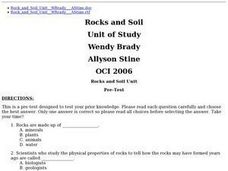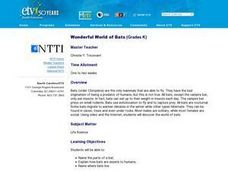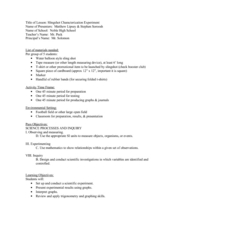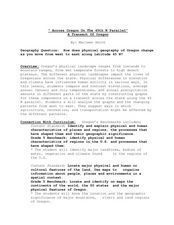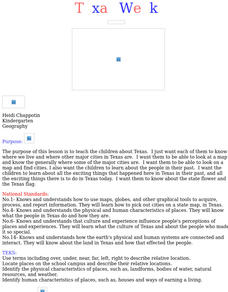Curated OER
Structures and Behaviors of Planarians
Students investigate planaria of the phylum platyhelminthes. They use DigiScope technology to observe and describe the structure and movements of planarians.
Aquarium of the Pacific
Turn a Cow into a Whale
Third graders explore animals that might have a common ancestor and resemble one another. For this cow and whale lesson, 3rd graders recognize the similarities between the whale and the cow. Students complete worksheets based...
Curated OER
Something's Fishy!
Students experience center activities to explore the habits and traits of fish. They observe a goldfish, play a memory game, complete artwork and read about fish.
Curated OER
Rocks and Soil
Students explore the physical properties of rocks. They explore the three different types of rocks and are able to compare and contrast their different properties. Students simulate the creation of sedimentary rock, they also...
Curated OER
Ecological Footprint
Eighth graders discover their own ecological footprint and create a plan for reducing this figure. They extend this to the school and community to see how they are doing on this scale. They discuss the concept of the ecological...
Curated OER
Sequencing the Cystic Fibrosis Gene: A Simulation
Ninth graders use this activity to simulate the sequencing of gene and to detect the presence of possible genetic defects. They use diagrams that represent bands of nucleotides in order to determine the sequence of a small piece of the...
Curated OER
Elephants
In this elephants interactive instructional activity, students read short passages of information about elephants before answering 10 multiple choice questions. They check their answers and start again if needed.
Curated OER
Math and the Greek-Golden Proportions
Fourth graders study math and the golden mean. In this math meets Greek history lesson, 4th graders study ratios and proportions in relation to the Greeks. The use of clay is incorporated ino this lesson.
Curated OER
Rivers Run Through It
In this mapping practice activity, 5th graders read an informational paragraph and answer 7 questions about the parts of a map along with places shown on a given map.
Curated OER
Making Tracks
Students cast animal tracks on a field trip. They split up to capture tracks from different areas and use plaster of Paris to mold to the footprint. They bring casts back to class, create a negative mold and paint it black.
Curated OER
Steamship Portland: Where's the Energy?
Students examine how steamships operate. They describe the necessary energy conversions. They construct a model paddlewheel ship. They use rubber bands as examples of potential and kinetic energy as they unwind and set the models in motion.
Curated OER
Creepy, Crawly Critters
Students study characteristics of insects by creating models from an assortment of materials. They create rubrics showing what an insect must have and create an insect, using a bag of materials. They cut out the puzzle insects included...
Curated OER
I Know What I Am... but, What Are You? (Classifying Living Things)
Learners examine how to classify living things by effects, environment, and activity. They explore various websites, develop a list of facts they learn about classifications, and participate in a distance online learning session with the...
Curated OER
Wonderful World of Bats
Students create a book about bats. They write a letter to a scientist containing questions about bats. They compare the socialization of bats to humans; compare the needs of bats to humans and other animals.
Curated OER
Slingshot Characterization Experiment
Students set up and conduct a scientific experiment to demonstrate data collection. In this scientific process lesson, students complete an activity with the specific objective of using a slingshot to fire a t-shirt into the crowd at a...
Curated OER
Paper, Microorganisms, and Biocides
Students study the paper making process and discuss the implications of recycling paper. Students conduct a lab to determine if microorganisms are present in different solutions used in the papermaking process today.
Curated OER
Manatee Endangered
High schoolers (or middle schoolers) research the endangered manatee and the Endangered Species Act. They choose a local animal that is threatened or endangered and attempt to find out what is being done to protect it. Short, but sweet,...
Curated OER
Lesson Plan on Migration
Fourth graders diagram written and oral directions of a Native American, European Viking, Right Whale or Humpback Whale migration route, the student diagram all directions only in the sequence given, with arrows indicating direction of...
Curated OER
"Across Oregon On The 45th N Parallel" A Transect of Oregon
Students explore the physical geography of Oregon. In groups, students collect weather and elevation information on Oregon. They organize the data and create maps and graphs of the information. Afterward, students compare the...
Curated OER
Metropolitan Areas in the USA
Fifth graders explore why people live in certain regions of the United States. They investigate information on specific metropolitan areas such as temperature, population, natural resources, precipitation and landforms. In groups, 5th...
Curated OER
Wright Brothers Centennial: North Carolina, Creation and Development of the State
Eighth graders examine technological advances and how they influenced the quality of life in North Carolina. Using maps, they locate the city of Kitty Hawk and discuss why it was chosen for the first flight. They read primary source...
Curated OER
Why Should We Clean The Beach?
Students volunteer for the International Coastal Cleanup. They describe the purpose of the Lake Michigan Foundation and a history of the dunes. They reflect on their experiences with writing.
Curated OER
Texas Week
Students explore Texas in the past and present. They pick out cities on a map and find information and analyze an Internet site.
Curated OER
Geography and World History
Students build off of their current knowledge of geography and world history, while being introduced to new concepts and ideas.





